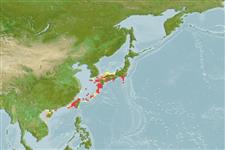Classification / Names
Κοινά ονόματα | Συνώνυμα | Catalog of Fishes(Γένος, Είδη) | ITIS | CoL | WoRMS | Cloffa
>
Pleuronectiformes (Flatfishes) >
Soleidae (Soles)
Etymology: Aseraggodes: Greek, aggos, -eos, -ous = vessel, uterus, carapace of a crab + Greek, aseros, -a, -on = to remove the appetite (Ref. 45335); orientalis: Named orientalis for its distribution in Japan and Taiwan (Ref. 74405).
More on authors: Randall & Senou.
Environment: milieu / climate zone / depth range / distribution range
Οικολογία
Θαλασσινό(ά) Υφαλόφιλο(α); εύρος βάθους 3 - 23 m (Ref. 74405). Subtropical
Northwest Pacific: Taiwan and Japan
Μέγεθος / Βάρος / Age
Maturity: Lm ? range ? - ? cm
Max length : 4.4 cm SL αρσενικό/απροσδιόριστο; (Ref. 74405)
Short description
Κλείδες προσδιορισμού | Μορφολογία | Μορφομετρία
Μαλακές ραχιαίες ακτίνες (συνολικά) : 69 - 72; Μαλακές εδρικές ακτίνες: 45 - 47. This species is distinguished by the following characters: D 67-72; A45-47, all branched; lateral-line scales 81-86; vertebrae 35 or 36; dorsal pterygiophores anterior to 4th neural spine 14; body depth 2.4-2.55 SL; head length 4.2-4.55 SL; caudal-peduncle length 7.75-9.9 in head length; snout length 2.65-2.7 in head length; preorbital length 2.5-2.95 in head length; eye diameter 4.7-5.15 in head length; interorbital space 7.6-10.5 in head length; tubular anterior nostril reaching edge of eye when depressed posteriorly; longest dorsal ray 1.55-1.65 in head length; caudal fin 3.55-3.95 in SL; pelvic fins reaching base of 3rd anal ray, 1.85-2.15 in head length, scales with 7-10 cteni, not projecting very far beyond scale margins; front edge of predorsal snout with 2 or 3 rows of slender cirri; ventral edge of head with a row of broad lappet-like cirri and 1 or 2 rows of slender shorter cirri above; color in alcohol pale yellowish with many small irregular dark brown spots, some in a line on lateral line; whitish with a few small brown spots on fin rays (Ref. 74405).
Life cycle and mating behavior
Γεννητική Ωρίμανση | Αναπαραγωγή | Γεννοβολία | Αβγά | Γονιμότητα | Προνύμφες
Randall, J.E. and H. Senou, 2007. Two new soles of the genus Aseraggodes (Pleuronectiformes: Soleidae) from Taiwan and Japan. Zool. Stud. 46(3):303-310. (Ref. 74405)
IUCN Red List Status (Ref. 130435: Version 2024-2)
Human uses
Εργαλεία
Special reports
Download XML
Διαδικτυακές πηγές
Estimates based on models
Preferred temperature (Ref.
123201): 20 - 26.9, mean 23.3 °C (based on 118 cells).
Phylogenetic diversity index (Ref.
82804): PD
50 = 0.5000 [Uniqueness, from 0.5 = low to 2.0 = high].
Bayesian length-weight: a=0.00977 (0.00466 - 0.02049), b=3.07 (2.90 - 3.24), in cm total length, based on LWR estimates for this (Sub)family-body shape (Ref.
93245).
Τροφικό Επίπεδο (Ref.
69278): 3.3 ±0.5 se; based on size and trophs of closest relatives
Ελαστικότητα (Ref.
120179): Υψηλό, ελάχιστος χρόνος για διπλασιασμό πληθυσμού < 15 μήνες (Preliminary K or Fecundity.).
Fishing Vulnerability (Ref.
59153): Low vulnerability (10 of 100).
